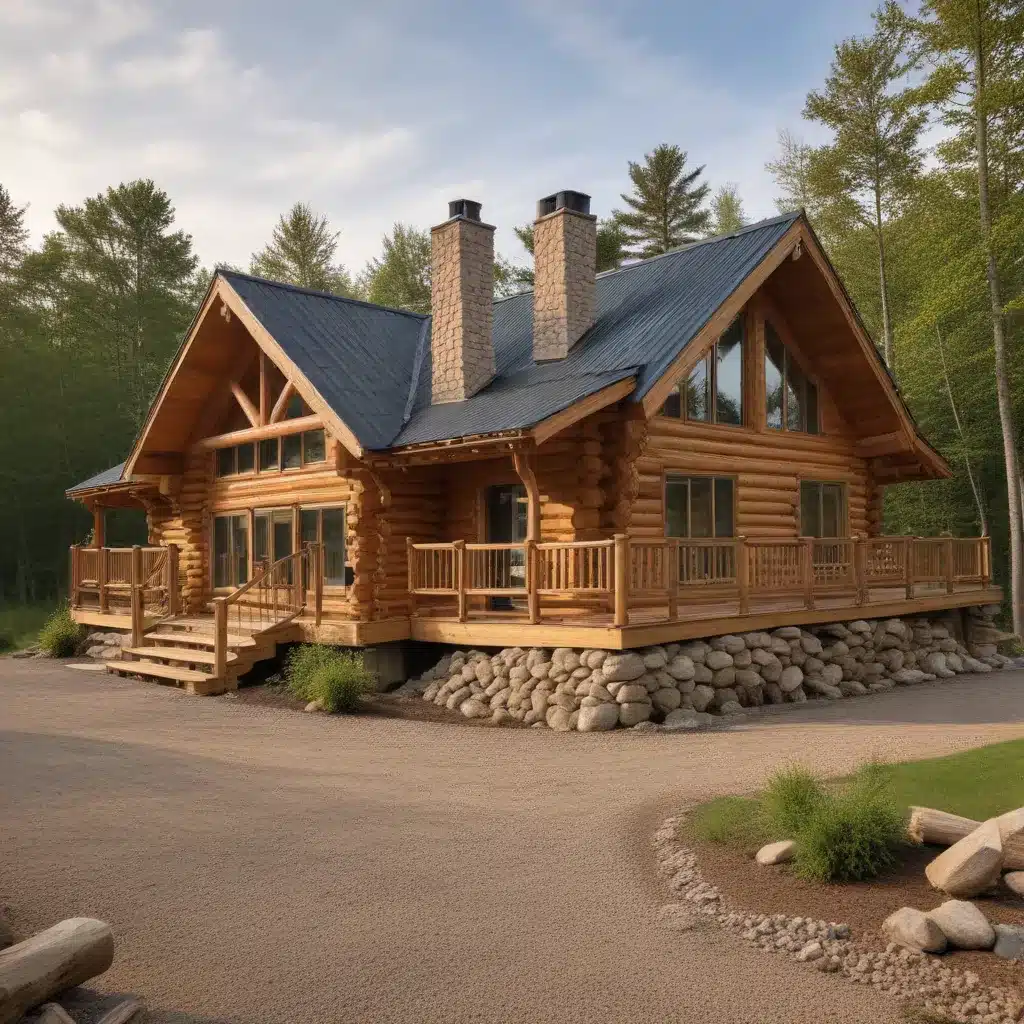
Designing for Thermal Comfort and Efficiency
Building a log home or timber frame structure requires careful consideration of thermal performance to ensure year-round comfort and energy efficiency. In the United States, log home enthusiasts have a variety of climate zones and environmental factors to account for, from the arid high deserts of the Southwest to the snowy regions of the Northeast. Crafting a well-insulated, thermally-optimized log home is essential for maintaining a comfortable indoor environment while minimizing energy consumption and operational costs.
One of the key aspects of thermal performance is the building envelope, which includes the walls, roof, and foundation. For log homes, the logs themselves provide a certain level of thermal mass, helping to regulate indoor temperatures. However, additional insulation is typically required to meet modern energy efficiency standards and provide optimal comfort. Blown-in cellulose, rigid foam panels, or structural insulated panels (SIPs) can be strategically integrated into the log wall assembly to enhance the overall thermal performance.
Proper air sealing is also crucial, as even the smallest gaps and cracks can lead to significant air leakage and energy loss. Carefully sealing all penetrations, joints, and interfaces with high-quality caulks, tapes, and gaskets can make a dramatic difference in a log home’s energy efficiency. Utilizing blower door testing during the construction process can help identify and address any problematic air leaks.
Fenestration Strategies for Passive Solar Gains
The placement and specification of windows and doors, known as fenestration, play a crucial role in a log home’s thermal performance. South-facing windows can be strategically positioned to capture passive solar gains, reducing the need for supplemental heating during the colder months. Carefully calculated window-to-wall ratios, along with the use of low-emissivity (low-E) coatings and argon gas fills, can optimize the balance between heat loss and solar heat gain.
In regions with hot summers, overhangs, shutters, or other shading devices can help mitigate unwanted solar heat gain and minimize the need for air conditioning. Thoughtful window placement and the use of high-performance glazing can create a comfortable indoor environment year-round, while minimizing energy consumption.
Thermal Mass and Passive Heating Strategies
Incorporating thermal mass into a log home’s design can be an effective way to store and release heat, further enhancing the overall thermal performance. Masonry elements, such as a thermal mass floor or a masonry fireplace, can absorb and slowly release heat, helping to regulate indoor temperatures and reduce the reliance on active heating and cooling systems.
In regions with significant temperature swings, such as the high desert areas, the strategic placement of thermal mass can be particularly beneficial. By capturing and storing solar energy during the day, the thermal mass can release heat at night, reducing the need for supplemental heating. This passive heating approach can lead to substantial energy savings and improved comfort levels throughout the year.
Energy-Efficient Heating and Cooling Systems
While passive solar strategies and thermal mass can significantly reduce a log home’s heating and cooling loads, the selection of energy-efficient mechanical systems is also crucial. High-efficiency heat pumps, either air-source or ground-source, can provide both heating and cooling with minimal energy consumption. In colder climates, a well-insulated and airtight log home may be able to utilize a smaller, more efficient heat pump system, further improving overall energy performance.
For supplemental heating, modern wood stoves or high-efficiency fireplaces can be an excellent choice, offering a cozy ambiance while reducing reliance on fossil fuels. When paired with a well-designed thermal mass system, these wood-burning appliances can provide efficient and effective heating during the coldest months.
Sustainable Materials and Construction Techniques
Constructing a log home or timber frame structure provides an opportunity to incorporate sustainable materials and building practices. Using locally sourced and renewable wood resources, such as responsibly harvested logs or engineered timber products, can significantly reduce the environmental impact of the construction process. Additionally, exploring the use of natural insulation materials, like cellulose or sheep’s wool, can further enhance the log home’s sustainability.
Incorporating energy-efficient appliances, LED lighting, and smart home technologies can also contribute to the overall energy performance and environmental friendliness of a log home. By embracing sustainable design principles and leveraging the latest advancements in building science, log home enthusiasts can create beautiful, comfortable, and eco-conscious living spaces.
Estimated Costs and Return on Investment
The upfront costs of constructing a high-performance log home can be higher than traditional stick-frame construction, but the long-term energy savings and improved comfort can provide a significant return on investment. According to industry estimates, the average cost of building a custom log home in the United States in 2024 ranges from $150 to $300 per square foot, depending on the size, location, and level of customization.
When factoring in the energy efficiency features, such as advanced insulation, high-performance windows, and efficient heating and cooling systems, the total construction costs can increase by 10-20% compared to a standard log home. However, the ongoing energy savings and reduced operational expenses can often offset these upfront costs within 5-10 years, making the investment in a thermally-optimized log home a wise long-term decision.
Conclusion
Designing and constructing a log home or timber frame structure that maximizes thermal performance is essential for creating a comfortable, energy-efficient, and sustainable living environment. By focusing on the building envelope, fenestration strategies, thermal mass integration, and high-efficiency mechanical systems, log home enthusiasts can enjoy the beauty and charm of a log home while minimizing their environmental impact and energy costs.
By embracing the latest advancements in building science and sustainable materials, log home owners can create a true oasis of comfort and efficiency, no matter the climate. With careful planning and attention to detail, the dream of a thermally-optimized log home can become a reality, providing year-round enjoyment and a lasting investment in the future.
For more information on custom log home construction and energy-efficient design, please visit Jorgensen Log Homes, a leading provider of high-quality log homes and timber frame structures in the United States.


